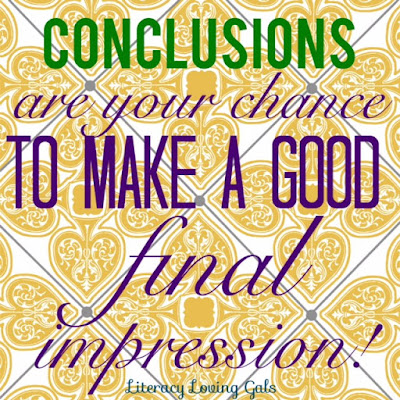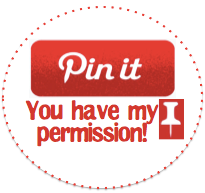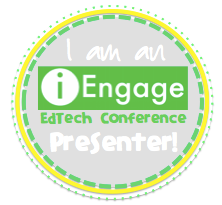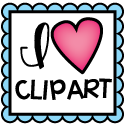Hello, hello! Boy, I can't believe summer is almost gone. I went to the Smekens Education Literacy Retreat mid-June and it's already the end of July. Now that I'm starting to get back into school mode, the rest of what I learned at the retreat will be made public soon. If you would like to view previous posts in, what I call, my mini-series, click HERE for Session 1: Achieving Complex Thinking During Reading and HERE for Session 2: Executing Complex Tasks After Reading. Okay, let's get started!
Session 3: Building Stronger Beginnings and Endings
Simply imagine a train engine and caboose when thinking of the introduction and conclusion in a piece of writing. Introductions are what grab or hook the reader to read more of a piece of writing, while a conclusion is what makes the writer's message remain with the reader.
To teach students how to compose well written introductions and conclusions, we were told teachers should first gather and organize writing samples to gauge and notice ingredients that make a piece of writing exemplar. Throughout the session, we were given access to numerous student writing samples from grades K-12. We sat in small groups and discussed what we thought made the pieces of writing *exemplar*. It was beneficial hearing what others had to say regarding particular pieces of writing. Not everyone at my table agreed on what was deemed exemplar. That's why it is important to use rubrics (which we did not have at the time). They provide some consistency in evaluating student work.
Besides viewing writing samples from students, to really get a sense of exemplary writing, Kristina Smekens, the presenter, suggested teachers pull out mentor texts and ask, What are the exemplar texts doing to grab your attention? What are the facets you're noticing? What are you seeing? Below are the titles of mentor texts with strong introductions and conclusions given to us at the retreat. I am familiar with many of the titles, but more than a handful of them were new to me, so I'm glad I have this as a reference. If you click on the images, you'll be able to get a better look at the titles, as well as download them for yourself.
Besides viewing writing samples from students, to really get a sense of exemplary writing, Kristina Smekens, the presenter, suggested teachers pull out mentor texts and ask, What are the exemplar texts doing to grab your attention? What are the facets you're noticing? What are you seeing? Below are the titles of mentor texts with strong introductions and conclusions given to us at the retreat. I am familiar with many of the titles, but more than a handful of them were new to me, so I'm glad I have this as a reference. If you click on the images, you'll be able to get a better look at the titles, as well as download them for yourself.
We were asked, "What are safe and typical introductions to a piece of writing verses what introductions can blow a reader out of the water?" Smekens explained how students tend to stick with safe introductions because that's all they know how to do. Teachers need to get students to STOP writing safe introductions similar to these: "Hello, my name is...and my topic is..." or "This is a report on..." These should be considered stick in the eye introductions, according to Smekens. ;) They do not make the reader want to dive into the piece of writing! Remember...
Introductions have 3 purposes:
- To Grab the Reader's Attention
- To Identify the Topic
- To Provide Context (This is where most students struggle.)
Teachers play a crucial role in the development of students' writing. The National Council of Teachers of English voiced how there is "empirical evidence that anyone can get better at writing, and that what teachers do makes a difference in how much students are capable of achieving as writers." Smekens advised us of a few things teachers can do to support students in becoming capable writers. For example:
- Show students what good writing looks and sounds like
- Display and discuss authentic samples of students' writing from years passed (or click HERE for benchmark samples for grades 1-5 and HERE for grades 6-8)
- Model good writing using example topics kids will not be using (otherwise they'll just copy you!)
- Advise students to avoid the word because in an introduction to prevent giving away too much information in the beginning (This is a common problem kids tend to make.)
- What do you want to leave the reader with?
- So what?
- So what's the big deal?
- Who should care?
- So what's your point? (Smekens, 2012)
Remember...
Depending on the type of writing your students are working on and the grade level you teach, you may find a few of these mini-lesson ideas helpful with your students when they are in the planning stage. Most of the resources provided at the retreat were geared toward opinion, persuasive, argumentative and informative writing, however the last resource is for narrative writing. Click on the images below for a better look and to download a copy for yourself. |
| Primary teachers could offer students sentence starters that suggest an introduction and a conclusion (Smekens Education, 2015). |
 |
| Before a student can align with a side of a topic/issue, they need to consider the pros and cons of both perspectives (Smekens Education, 2015). |
 |
| Suggestion: Take students to various places within the school and have them notice specific details using this activity. Below is a student sample. |
Skillfully written introductions and conclusions take time for students to produce. If you don't plan opportunities for your students to participate in authentic writing experiences to grow as writers, who will? Don't leave it to someone else to teach your students to write well. Be that someone and remember...















































Thank you for a fantastic post! Helping my students to include a strong beginning (and ending) in their writing has been a challenge. I'm looking forward to using your ideas this next school year.
ReplyDeleteThanks again!
Melissa
Real Life in First Grade
Thank YOU, Melissa, for reading my post and commenting! I hope the tips I shared from the retreat will help your little firsties. :)
Delete